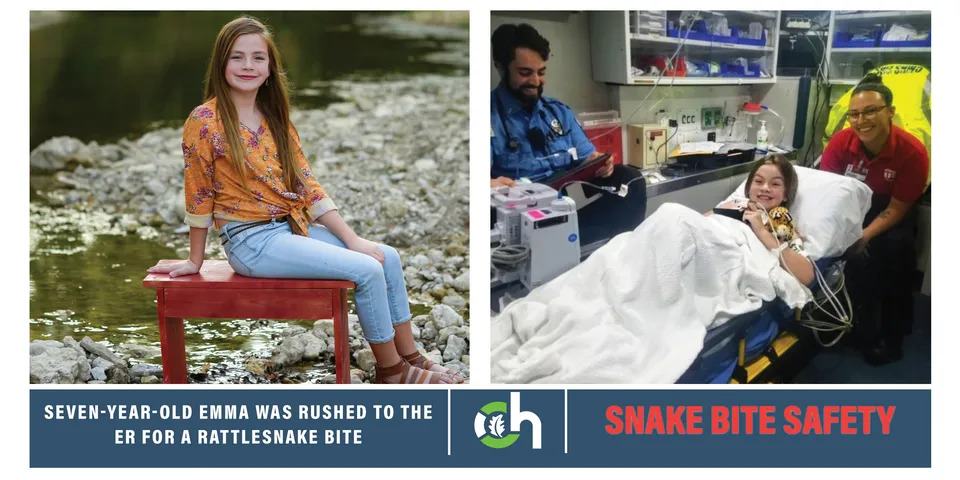
July 31, 2020
Central Texas is prime breeding ground for rattlesnakes and summer is the height of snake bite season. Getting bit by a venomous snake can be very scary, and can lead people to react in exactly the wrong way.
How should a person respond to a snake bite? Read how Emma Lee Burks was bit by a snake when she was only seven-years-old while playing hide and seek with her brother and cousins.
Emma Lee Burks’ Story, as told by her mother and father.
On September 1, 2018, Emma climbed in a small tree in the backyard. When she came down from the tree, she landed too close to a snake and was bitten twice on the instep of her right foot. She immediately found her dad and told him she had been bitten by a snake. Emma’s father, Jeffrey Burks, trained paramedic, drew two circles around the fang marks on her foot and wrote the time. Burks’ medical training kicked in, “This is so the medical professionals could document the swelling. I knew she needed to get to the closest ER with CroFab antivenin, as fast as possible,” recalls Jeffrey Burks, Emma’s dad and paramedic, “Time is your enemy in a venomous snake bite situation and the faster she received appropriate medical treatment, the better off she would be.” Emma was not sure of the type of snake that bit her. The Coryell Health ER staff drew blood to check her platelets and other blood clotting factors.
“Blood work showed Emma’s platelets were low which can be concerning for a possible venomous snake bite,” recalls Burks. “Coryell Health Emergency Department Doctor and nurses started her on CroFab antivenin and only then did they arrange her transport to a children’s hospital for further treatment.
It is important to know the closest hospital in your area that carries CroFab. As a paramedic, I was aware that CroFab could treat rattlesnake, cottonmouth and copperhead bites, so you don’t have to know for certain which one it was, although we believed it was a rattlesnake that bit Emma.” Due to the quick thinking of her dad and the Coryell ER staff, only an hour lapsed from the time Emma Lee was bitten until she received her first dose of CroFab.
After a full recovery and two years later you would never know she was bitten. Emma’s mother recalls that upon return from the hospital, Emma immediately ran outside barefoot. “I believe Emma watches more than before, but we don’t want to live in fear. We know what to do and thankfully, she has no scars – just her story!”
What Should You Do if You or Someone Else is Bitten by a Snake
While snakes typically try to avoid humans and only bite when they feel threatened, nearly three million people worldwide are poisoned every year after experiencing a venomous bite. Only a fraction of these bites are fatal, but toxins in snake venom can trigger serious medical emergencies that occur within hours; they can cause organ failure, uncontrollable bleeding, severe tissue destruction and paralysis that may restrict breathing, according to the World Health Organization (WHO).
“With some types of snakes, like rattlesnakes, redness and pain at the bite site develop within minutes, while with other venomous snakes, such as copperheads, the symptoms may take longer to appear. Don’t wait to see what kind of bite you may have, call 911 so EMS can take you to closest appropriate Emergency Room,” says Daniel Lay, Coryell Health EMS, EMT-P Deputy Chief.
“Before the patient reaches a medical facility, the wound should be kept clean and the affected limb should be elevated to reduce the effects of the venom. If the victim or a bystander has a fitness tracker, they can use it to monitor heart rate,” adds Lay. “If you’ve been bitten by a snake and you’re transported by EMS after a call to 911, the responders will be sure to take you to a hospital that has antivenin. If you’re driving yourself, that’s another variable in the equation of ‘did you drive to a place that doesn’t stock the anti-venom’, and that would be time and tissue lost.”
After being bitten, remaining calm and still can also help to slow the venom’s spread, the Centers for Disease Control and Prevention (CDC) says.
What NOT to Do if You or Someone Else is Bitten by a Snake “Despite what movie and TV Westerns would have you believe, victims of snake bite shouldn’t try to suck out the venom from the bite site or release it by cutting themselves,” stresses Lay. “After a bite, venom floods the body’s tissues and is impossible to remove through suction. Cutting is equally useless for venom extraction and can result in serious injury,” he adds.
“You shouldn’t ice the bite, use steroids or consume alcohol, and do not apply a tourniquet, if bitten by a native North American snake. It is a less is more- until you get medical care- type of situation. There’s a lot of things people do that aren’t going to help a snakebite, and could potentially make it much worse.”
Resources and Contributions
Special thank you to Emma’s parents, Marlena Tippit and Jeffrey Burks, for sharing her story so others will know how to respond in a similar situation.
Locate a CoFab hospital near you
 Skip to content
Skip to content
